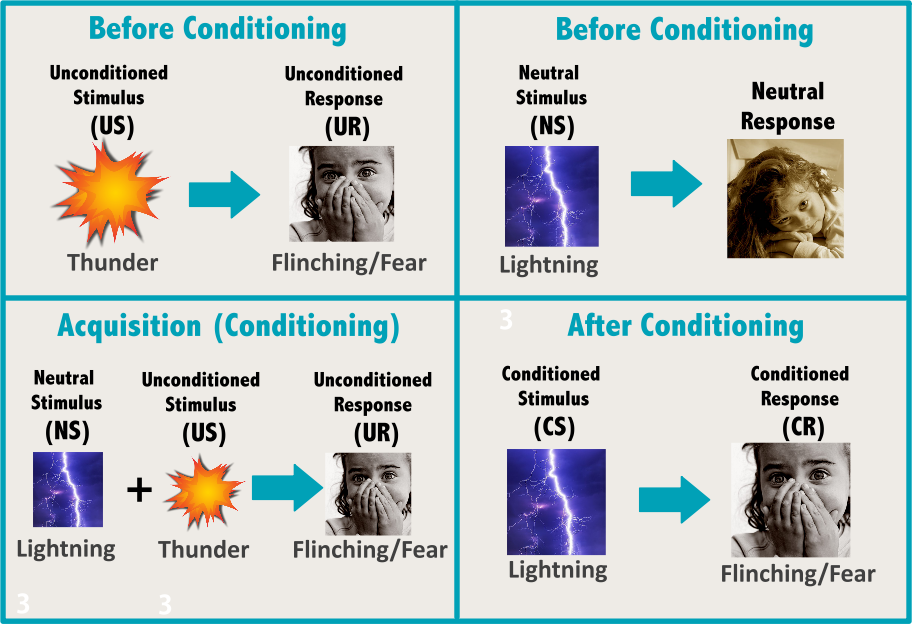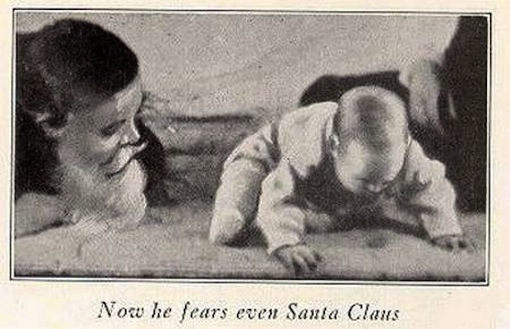Dalia Savy
John Mohl
Jillian Holbrook
AP Psychology 🧠
334 resourcesSee Units
What is Classical Conditioning?
Classical Conditioning is most closely associated with the work of Ivan Pavlov, which is why it is also known as Pavlovian Conditioning. Classical Conditioning involves presenting a stimulus that makes the organism respond in a certain way. When paired with another non-related stimulus, the stimulus forms an association between the two. The non-related stimulus begins to evoke the same response that the original stimulus does.
The graphic below shows how Pavlov paired a neutral stimulus (bell/whistle 🔔) with an unconditioned stimulus (food) to elicit a conditioned response (salivation) from the whistle alone.
🎥 Watch: The Office—Classical Conditioning
Image Courtesy of Open Source Textbook.
The Stimulus & The Response
The stimulus (plural: stimuli) can be anything perceivable by the five primary senses. It can be a sight, sound, taste, smell, or something that can be felt. The response in Classical Conditioning is any reflexive, non-voluntary behavior, i.e., something that one cannot readily control. Usually, Classical Conditioning involves a stimulus that causes an automatic physiological response. Sometimes this involuntary response is known as respondent behavior.
Examples of reflexive, involuntary responses (respondent behaviors):
- 💓 Heartbeat/ Heart rate
- 😤 Breathing/Respiration
- 🤤 Salivation (mouthwatering)
- 😲 Startle response
- 🤢 Nausea
- 🥶 Shivering
- 😏 Sexual Arousal
Some of the stimulus-response pairings (or contingencies) result from the experiences of our environments. We have learned to react to certain stimuli in a certain way. For example, if a one-hundred-dollar bill is placed in our hands, we might feel our bodies respond as a result of the excitement we might feel: our heart rate and respiration might go up. 💵
However, we were not born to react that way; giving that same hundred-dollar bill to a baby would not yield the same reaction. When a response to a stimulus is the result of learning, we refer to it as "conditioned," or a conditioned response (CR). The stimulus that causes the conditioned response is called the conditioned stimulus (CS).
Some of these stimulus-response pairings (or contingencies) are natural, innate, and unlearned. That is, we are born to react to certain stimuli in a certain way. When a light is shined in one's eyes ☀️, the pupils constrict; this is a natural process. When a response to a stimulus is natural/unlearned, we refer to it as unconditioned or an unconditioned response (UR). The stimulus that causes the unconditioned response is called the unconditioned stimulus (US).
A classic example of Classical Conditioning is thunder and lightning⚡:
Lightning on its own is not what causes us to flinch in fear when we see it close by. It is an implicitly conditioned response due to its association with the loud crack of thunder that we have learned will follow shortly. Thus, lightning begins as a neutral stimulus by itself, but through conditioning, becomes a conditioned stimulus that elicits the conditioned response of flinching in fear. The conditioning explains why we flinch in fear even before the thunder has time to sound because we learned to predict what is coming next, and our bodies react involuntarily in anticipation of the pending crack of thunder.
Classical Conditioning Model:
- NS - lightning ⚡ *causes no response
- US - thunder 💥 ➡️ UR - flinching 😱
- NS - lightning ⚡+ US - thunder 💥 ➡️ UR - flinching 😱
- CS - lightning ⚡ ➡️ UR - flinching 😱

Graphic Courtesy of Kyle Rolofson | Images Courtesy of commons.wikimedia.org
Conditioning Processes
During the acquisition stage, a neutral stimulus (NS), which does not produce a noticeable response, acquires the ability to affect the same response as the unconditioned response. In AP Psychology, the neutral stimulus is usually presented before the unconditioned stimulus, which naturally produces the unconditioned response. After numerous pairings of the neutral stimulus and unconditioned stimulus, the neutral stimulus creates the response by itself. What was once the neutral stimulus becomes a conditioned stimulus, and the reaction to it is a conditioned response.
If a conditioned stimulus is presented numerous times without being paired with the unconditioned stimulus, there may be less of a conditioned response, and it may even eventually cease. In this instance, the conditioned response has gone into extinction. Extinction is when a conditioned stimulus no longer produces a conditioned response.
Even when extinction occurs, there are times in which the conditioned stimulus, having been shown to no longer produce the conditioned response, will unexpectedly affect the conditioned response. This process is referred to as spontaneous recovery. Spontaneous Recovery is a time following extinction when a conditioned stimulus restarts to create the conditioned response.
Image courtesy of Open Source Textbook.
Stimulus Generalization, or generalization, refers to when stimuli similar to the conditioned stimulus also produce the conditioned response. For example, if a person is conditioned to have an elevated heart rate at the appearance of a green ball and shows that same conditioned response to anything green, the conditioning is considered generalized.
Stimulus Discrimination is the exact opposite of generalization. Not only does a similar stimulus fail to produce the conditioned response, but the actual conditioned stimulus can only produce it as it was originally presented. In the previous example, a person has been conditioned to respond to a green ball. However, the response only occurs in response to that shade of green.
However, not all conditioning is based on an original stimulus-unconditioned response pairing:
For example, a worker who becomes excited (e.g., elevated heart rate) at the sight of their paycheck very likely did not have the bodily conditioned response because the paycheck was originally paired with something that naturally produced that type of bodily response. The response was very likely produced by money or the reception of money which in itself is not an unconditioned stimulus (that is, it is not natural). Instead, the conditioned stimulus was established as the money, as it was paired with some other type of stimulus. Because the paycheck-excitement contingency was initiated on a previously conditioned stimulus, it is referred to as higher-order conditioning. Higher-order Conditioning refers to conditioning that is built on previously established conditioning.
Table Summary
| Key Term | Definition | Example and Emoji Representation (pretend 💨 represents a whistle) |
| Neutral Stimulus (NS) | Stimulus that elicits no response (before any conditioning happens) | In Pavlov's dog example, the whistle is the NS. If it is blown before conditioning, the dog does nothing. 💨→😑 |
| Unconditioned Stimulus (US) | Stimulus that implicitly triggers a response. (before any conditioning happens) | The US is the dog's food. When the dog sees food, it already has a reaction and becomes hungry. 🦴→🤤 |
| Unconditioned Response (UR) | A natural response to the US. (before any conditioning happens) | The UR is salivation. When a dog sees the dog food (US), it automatically salivates because it's hungry. 🦴→🤤 |
| Conditioning | The goal of this experiment is to make the dog salivate when the whistle is blown. This obviously isn't a natural reaction, so you must (classically) condition the dog to react like that. | In order to do this, Pavlov showed the dog food while blowing the whistle. Eventually, the dog began to associate the whistle with food and salivate when hearing it. 💨 + 🦴→🤤 |
| Conditioned Stimulus (CS) | The NS turns into the CS. The CS is what one would learn and, in turn, respond. (after conditioning occurs) | The whistle is now the CS since the dog began to associate food with the sound of a whistle. 💨→🤤 |
| Conditioned Response (CR) | A learned response to a CS. (after conditioning occurs) | Salvation to the whistle is the conditioned response. The dog learned and, again, began to associate the sound of the whistle with food, salivating when he hears it. 💨→🤤 |
| Acquisition | When the NS and US are linked together so that the NS triggers the CR. Through acquisition, the NS becomes the CS. | Before, the whistle triggered no response. However, during conditioning, food and the whistle were linked and now the whistle causes salivation. 🦴→ 💨 which →🤤 |
| Extinction | When the CS no longer causes the CR to happen. | Over time, the dog will learn that there is no food that comes with the sound of the whistle and it stops salivating when a whistle is blown. This is called extinction. 💨→😑 |
| Spontaneous Recovery | When the CS suddenly begins to trigger the CR. (randomly after extinction) | When the dog starts to salivate at the sound of the whistle after a long time of not doing that. Randomly . . . 💨→🤤 |
| Generalization | Triggering the CR to a stimulus similar to the CS. | The dog begins to salivate when it hears the sound of a whistle and the sound of a bell, even though it isn't conditioned to salivate to the sound of the bell. 💨→🤤 and 🔔→🤤 |
| Discrimination | When the CR only occurs to a specific CS. | The dog doesn't salivate at the sound of every whistle—it only salivates to the sound of a particular whistle. 🔊💨→🤤 |
Experiments to Know
John B. Watson's Little Albert Experiment
In this infamous and unethical experiment, behaviorist John B. Watson used the classical conditioning model to condition a baby boy named Albert to have a phobia for white rabbits. He presented Albert with the white rabbit and other animals, like a dog and a monkey, to which Albert showed no response other than perhaps curiosity. Then, when Watson presented the white rabbit to Albert, he also struck a loud metal bar, making a loud noise that would startle Albert and cause him to cry. He repeated this process multiple times until Albert began reacting negatively and crying at the presentation of the white rabbit alone.
John B. Watson proved that one could learn to have a phobia from the classical conditioning model. Watson then experimented with other stimuli to test for stimulus generalization and discrimination, such as presenting Albert with the dog, the monkey, and other things like a white Santa beard to see if they evoked a fear response such as the rabbit had been conditioned to do.
🎥 Watch: Little Albert Experiment - Original Footage

Image Courtesy of Commons.wikimedia.org
John Garcia and Taste Aversion in Rats
Psychologist John Garcia used aversion conditioning to show the influence of biological preparedness in Classical Conditioning. Biological preparedness is the idea that people and animals are innately prepared to form associations between certain stimuli and responses more readily than others. To illustrate this, he presented rats with three different neutral stimuli (saccharine water, a noise, and a light) while also hitting the rats with mild radiation that would cause nausea.
The rats associated nausea with the saccharine water and refused to drink it (aversion conditioning), showing a conditioned taste aversion. However, they did not show any conditioning to the noise or the light, which indicates organisms are biologically prepared to form associations between stimuli and responses that are critical to survival, such as with food/drinking and subsequent digestive problems/sickness.
🎥Watch: AP Psychology—Classical Conditioning
Browse Study Guides By Unit
🔎Unit 1 – Scientific Foundations of Psychology
🧠Unit 2 – Biological Basis of Behavior
👀Unit 3 – Sensation & Perception
📚Unit 4 – Learning
🤔Unit 5 – Cognitive Psychology
👶🏽Unit 6 – Developmental Psychology
🤪Unit 7 – Motivation, Emotion, & Personality
🛋Unit 8 – Clinical Psychology
👫Unit 9 – Social Psychology
🗓️Previous Exam Prep
📚Study Tools
🤔Exam Skills

Fiveable
Resources
© 2025 Fiveable Inc. All rights reserved.